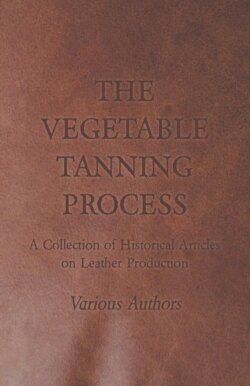The Vegetable Tanning Process - A Collection of Historical Articles on Leather Production

Реклама. ООО «ЛитРес», ИНН: 7719571260.
Оглавление
Various. The Vegetable Tanning Process - A Collection of Historical Articles on Leather Production
The Vegetable. Tanning Process
Contents
THE VEGETABLE TANNING MATERIALS
SECTION I. TANNING OR TANNIC ACID
1. Vegetable tannage
VEGETABLE TANNED SOLE LEATHER
Vegetable Tanning
Theory of Vegetable Tanning
Отрывок из книги
A Collection of Historical
Articles on Leather
.....
At the same time that the alkaline is being replaced by the acid swelling, the surface of the leather is taking colour, most rapidly indeed if the hides are somewhat limey; and actual tannage gradually penetrates, so that by the end of the suspender period, the hide, if not tanned, should be nearly or quite “coloured through.”
At the end of the suspenders the butts, still soft, are advantageously laid flat to straighten out any lumps or creases which may have formed, before they go to the “handlers.” Though the time of suspension is short and the liquors weak, the latter must be abundantly supplied, for the green hides have great avidity both for tannin and acid, and if allowed to remain in exhausted liquors, putrefaction sets in, which brings down the hides as in a bate, and renders it impossible later to produce a firm and plump leather. Too great astringency, on the other hand, is equally dangerous, since it also checks swelling, and hardens the surface, producing perhaps a “semi-permeable membrane,” which it is very difficult for the tannin to penetrate later. Such liquors also cause “drawn grain,” for if the surface of the hide is fixed by too early tanning, and the interior afterwards swells in thickness and contracts in area, the grain becomes puckered in wrinkles which are the larger and coarser, if through ill-managed liming the fibrous texture immediately below the surface is too much loosened.
.....